LabGuy's World: One Inch Format
VTR's
NEW! 02.10.14
 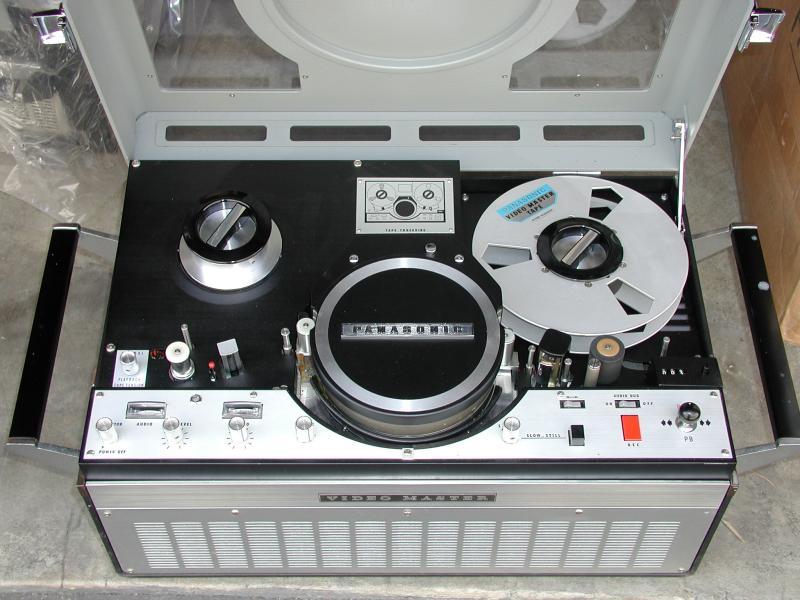  
1968?: Panasonic NV-204 One Inch B/W Video Recorder!
SOLD!
|
Here is a very rare one inch VTR from Panasonic. It is B/W normally, color
capable with an external adapter. The first photo shows the NV-204
with the cover closed. Second photo is a glamour shot of the tape transport
and control panel. Third photo is the connector I/O panel on the rear of
the machine. In the fourth photo, is the NV-A100C remote control unit for
the VTR. Anyone have a spare remote cable?
This VTR has a built in speaker for audio monitoring. There is provision
for an external speaker if desired. Two convenient video output jacks.
There is a convenience AC outlet as well. This can power either a separate
video camera or a video monitor. Audio in and out is by way of professional,
balanced audio, XLR connectors. |
The NV-204 is a two head, half helical machine with one audio channel and
no time code or any other modern conveniences. Operation is controlled
from a four way joystick style lever. The functions are: play, record,
rewind, fast forward. Center position is stop mode. There are separate
meters to monitor audio and video levels. The audio track can be dubbed
over. Horizontal resolution is claimed to be greater than 350 lines. The
NV-204 has stop motion with variable speed play in both forward and reverse.
Stay tuned! Scans of
the operator's manual will be posted very soon!
CLICK HERE to read the operator's
manual for the NV-204.
NEEDED: Service manuals for
this VTR. |
NEW! 02.06.19
 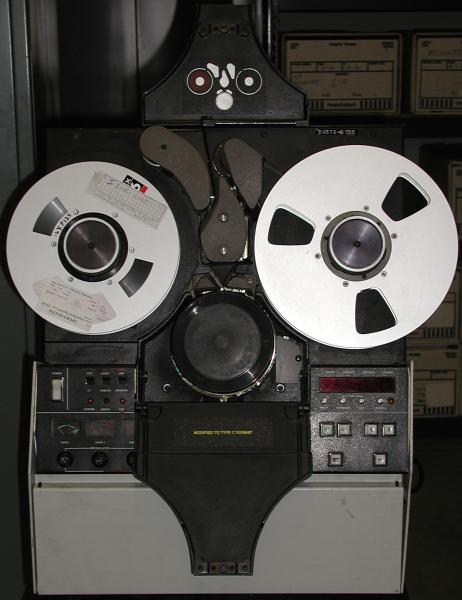   
Ampex VPR-1 Type C Format One Inch Broadcast Video
Recorder!
Here is the first 1 inch type C format machine from Ampex. But, it wasn't
always so! When this VTR was originally introduced in 1976, it was type
A format! But, Sony was working on a system so similar to the Ampex type
A format, that it was actually possible to go back and retrofit early VPR-1s
to the new Type C format. This is one of those machines! It is clearly
labeled on the bottom of the two tape path covers. "Modified to Type C
Format", it proudly declares and can be clearly seen in the last photo.
The type A format was a single
head, full alpha wrap design. This means that the tape was wrapped almost
all the way around the head drum. The shape of the tape path resembled
the Greek letter Alpha, hence the name. Conversely, on two head machines,
the tape wrap resembles the Greek letter omega, hence the term "omega wrap.
The shortcoming of the original Ampex type A format was that for a brief
moment, the video head leaves one edge of the tape, crosses a small gap
and then recontacts the opposite edge of the tape. During this "crossover"
time, there is no video signal. Ampex's solution was to time the rotation
of the head drum to place the crossover drop out in the vertical interval
and insert an artificial sync pulse. This process could not be broadcast
and still conform to FCC required practices.
An omega wrap machine avoids
this by using two video heads and a tape wrap slightly greater than 180
degrees. This way there is always one head in contact with the tape and
at the vertical interval both heads are in contact with tape. The down
side to the omega wrap system is the tape only circumscribes half the drum, |
cutting the relative head to tape speed in
half when compared to a single head system with the same drum diameter.
Sony's solution was very ingenious
and was demonstrated on some of their earlier video recorders. It is called
the "one and a half head system". A second video head is placed on the
head drum some number of degrees behind the main video head. While the
main head is crossing over, the second head is reading from a short, sort
of in between, video track that contains only the vertical interval information.
In this manner, the machine can reconstruct a continuous, uninterrupted
video signal! Plus, the relative head to tape speed benefits of the single
head system! Thanks, Sony!
This machine supports two sound tracks
for stereo, a cue track for a second audio channel or linear time code,
as well as VITC (vertical interval time code). It has three video outputs,
two for program and one for monitor. Inputs include all of the audio channels
mentioned as well as video input and reference sync input. All electronics
are contained on plug in circuit boards located in both the front and rear
of the unit.
It can accommodate 10-1/2 inch
reels allowing for up to 90 minutes of record / play time. The companion
time base corrector is the Ampex TBC-1, which I have and which will be
covered in an upcoming new museum page. Stay tuned for that!
NEEDED: Service and operator's
manuals for this VTR. |
NEW! 02.04.04
 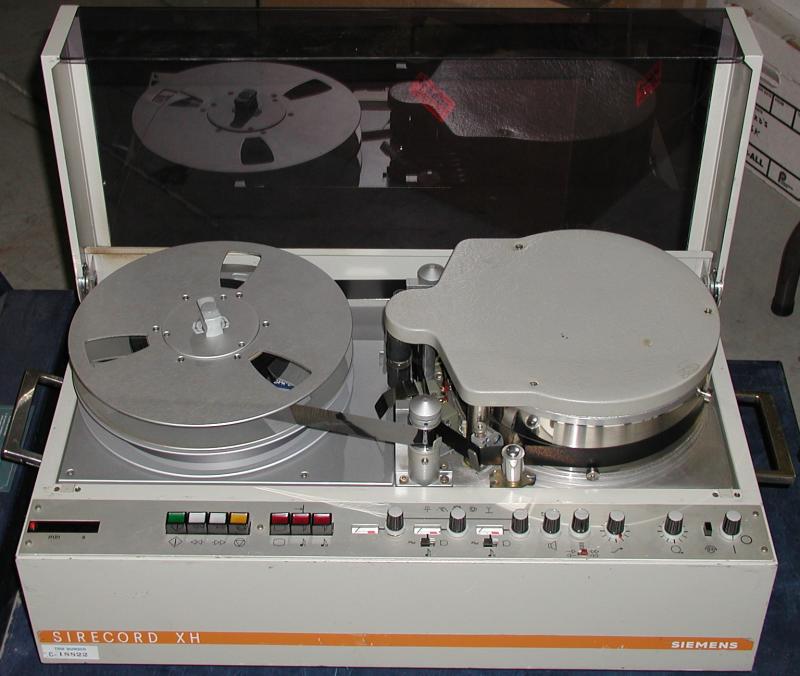   
Siemens SIRECORD XH One Inch Medical Video Recorder.
Thanks go out to Michael (Duncan)
Geier for alerting me to this item. Mike spotted this VTR in a flea
market in Anaheim California on Sunday. Two emails and a phone call later,
the Siemens SIRECORD XH is delivered to LabGuy's World the very next Thursday!
It arrived in excellent condition, except for a chopped off power cord.
Which is no problem at all.
This is a half helical
VTR with stereo sound capability. Manufactured by Siemens AG in Germany.
Production year is not known. I am not sure what the intended application
for this machine was, but I was told that it was removed from a medical
system. The X in a VTR model number is usually included in the model numbers
of machines that have been specifically certified for medical use. The
tape reels are 10.5 inches in diameter and the tape width is one inch.
Tape speed and running time is unknown. The tape reels are stacked one
on top of the other to save space. This is called Coaxial Reels.
The bottom reel feeds tape and the top reel takes it up. The circumference
of the head drum is 30 inches and the diameter is 9.55 inches. Revolving
at 30 revolutions per second, the head to tape speed comes out to 900 inches
per second which is very respectable. The tape travels around the drum,
traveling upward in a helix, hence the term; Helical Scan. As the
tape travels around the drum, it is held in precise register by a series
of strategically placed guide pins. The capstan and pinch rollers are located
dead center between the head drum and the tape reels. The tape passes through
the capstan pinch roller twice on its way around the head drum. This arrangement
maintains a very even tension on the tape, essential to high quality tracking.
The overall size is 11 inches high, 26 inches wide and 16.5 inches deep.
Not very compact, in fact it's HUGE! and HEAVY! The entire deck weighs
120 pounds (54. 5 kilos). The |
VTR unit rests on a pair of spring loaded
runners to absorb (block?) vibration. The machine runs on 220 volts, 60
Hz. It consumes a whopping 200 watts! If I can borrow a step up transformer,
I will replace the power cord and see if it operates.
The connectors are not standard
BNC or UHF types that I am familiar with. Can anyone help me identify,
and possibly obtain, these video plugs? The audio DIN style connectors
are familiar and available. Also, all of the markings and labels on the
machine are pictorial icons. I suppose that is because this machine was
intended for international marketing. I'm sharp as a marble, and I can't
figure them out just by looking! I guess I will have to put power to this
VTR and apply the religious method of identifying the functions; "Seek
and ye shall find"! Hey! That's the way I type, too!
Update Info! 02.04.07:
Bruno Merlier confirms
that the video jacks are of a type he has seen on a Philips medical video
monitor he once had. Now, that I think of it, when I used to work at Merlin
Engineering, way back in 1985, my primary job was converting Hitachi HR-200
one inch type C broadcast VTRs to a 1,000 scan line medical format for
~ who else? ~ Philips Medical Systems! The video monitor I used for final
test had a round CRT and the deflection yoke could be rotated so that the
X-Ray image could be conveniently oriented for the surgeon. The videotape
that I was given for testing purposes was of a patient receiving cardiac
angioplasty.
NEEDED: Service and operator's manuals for this VTR. |
NEW! 01.06.21
 
Ampex / Nagra VPR-5 One Inch Type C Field Production
Video Recorder.
|
Thanks go out to TapeWorks Recording
Studio for the wonderful bargain. I have had this baby listed
as my number one desire on LabGuy's Wish List page from the very first
day that I started this site. Well, here it is! This is a late production
model of the famous 1" type C format portable field production VTR manufactured
in 1986. Stereo sound tracks of unequaled quality, full time code support,
5 MHz flat bandwidth direct recording at 1,008 inches per second! This
example is absolutely fully functional, almost a first for LabGuy's World!
The first photo shows the large 60 minute reel arrangement and the second
photo shows the smaller 20 minute reels. The hub/motor assemblies can actually
be rotated into two separate positions to accommodate the different size
reels. (Unfortunately, I've got them in the wrong position in the second
photo!) Tension control automatically adjusts itself according to these
configurations as well! |
For more information than I can provide here, visit: THE
(Unofficial) AMPEX/NAGRA VPR-5 WEB SITE in the mean time to read a
brilliantly written description of this work of art. ~ Stay tuned for continuing
updates! ~
SIDEBAR:
I've recently acquired
an Ampex TBC-2B, direct color and/or heterodyne color, Time Base Corrector
to go with my Ampex and IVC VTR's. It may work some of my other misc. VTR's
too. Stay tuned for more info and photos on that project.
.
The one who dies with the most VPR-5's wins! [CLICK
HERE]
.
Coming Soon: LabGuy's TBC Museum Page! |
New & Better Photos! 01.05.21
  
1966 Ampex: VR-6275 consolette - home VTR
And an historical photo with tape reels!
Ampex Type A Format. 1" tape, 1 head, alpha wrap. It has built in a television
receiver, audio amplifier and speaker, but NO clock that flashes,
"12:00", "- - : - -",
"12:00", "- - : - -",
"12:00", "- - : - -".
That had not been invented yet!
This VR-6275 is housed
in a decorative furniture grade cabinet, implying to me, that it was intended
to blend in with other furniture. That qualifies this machine as a "Home
VTR". This is the largest VTR in the museum's collection. Plainly
marked: "Manufacture date: 1966" making it the largest "Home VTR" in my
collection!
UPDATE: 01.05.21:
This product appeared
in the Burstein-Applebee 1967 Annual Catalog. The VR-6275 is listed for
$1495.00. A VR-6200 VTR only, without the TV control center, lists for
only $1450.00! An accessory video camera outfit lists for $589.00 and a
30 minute roll of tape is a mere $44.95 and a 60 minute tape is only $59.95!
No wonder Ampex didn't sell very many of these!
I've found a magazine
article, dating back to May, 1966, about this very machine! The article
was written by Joseph Roizen, the man who recorded and then helped to smuggle
the famous Nixon / Kruschev "kitchen debate" video tapes out of Moscow
in the early 1960s. These tapes were some of the earliest demonstration
of color video recordings in history! Mr. Roizen worked for Ampex at the
time this article was written, but later also worked at IVC. |
Update info about
Mr. Roizen 02.04.07:
I received information
recently that Joseph Roizen is no longer living. If you would like to read
more about this remarkable man, [CLICK
HERE]. This page is a memorial to a man I never met, only knew of by
rumor, but whom I have come to respect for his contributions to video state
of the art at both Ampex and IVC.
Here is the official description of the
VR-6275:
The Model 6200 consolette,
which includes deck, base and video control center, costs $1495. The control
center contains TV receiver front end circuits for making a recording but
no display monitor. The center also permits the recorder to be connected
to any TVset's antenna terminals to allow the set to be used as a monitor
during playback. The recorder weighs just under 100 pounds and will record
and play back a one hour program using special one inch video tape. A 10
inch reel of this tape (3000 feet) costs $59.95. The video head used is
expected to have a minimum life of 500 hours with a replacement cost of
under $35. A tape made on one of these recorders can be played back on
any other similar Ampex recorder.
WANTED: Service manuals, operators manuals, advertisements, magazine
articles, belts, idler wheels, tape(s) and a take up reel for this machine.
Contact me if you have any of these items available. Let's haggle! |
New! 02.07.28
Updated! 02.08.20
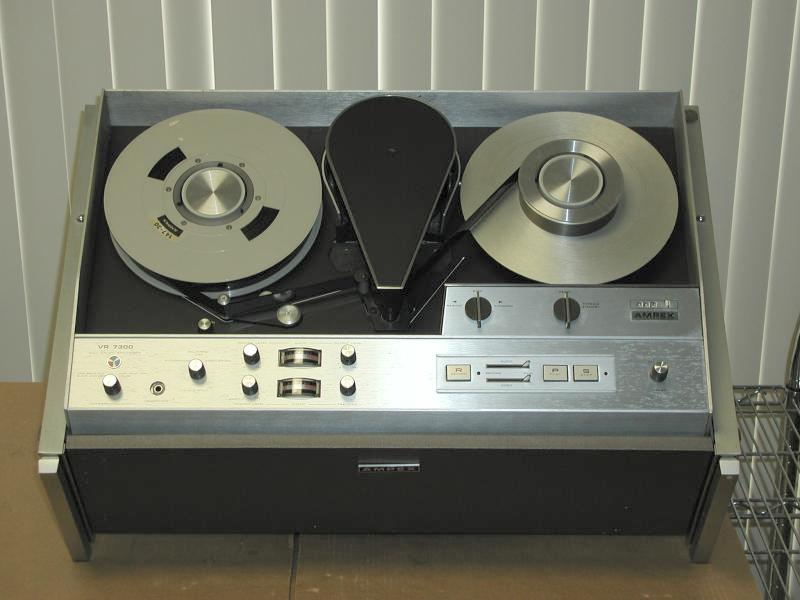  
  
1968: Ampex: VR-7300 Color Capable VTR and Matching
Color Converter Unit!
Ampex Type A Format. 1" tape, 1 head, alpha wrap. Manufactured by Ampex
of Elk Grove Village, Illinois in the late 1960s. High / Low band operation
with color capability in the high band mode.
This beast is heavy!
On the scale, it weighed 103 pounds! (49 Kilos!) It is 29" wide, 18" deep,
and 15" high.
For color playback, an
external playback adapter was required. This color adapter is shown in
the last photo. The Ampex part number of the color adapter is: 7017-924.
This adapter was used to stabilize the color signal during playback. No
adapter is required for color recording. The color adapter uses a "pilot
tone" that is derived from the original color signal. The pilot tone is
then used to subtract the timing errors from the color signal during playback. |
Starting in the second photo, moving left
to right, the various controls are as follows: Low Band / High Band select.
Audio Input select. Audio and video record level pots. Audio and video
record level meters. Audio playback level and Video tracking pots. (third
photo) Across the top, tape mode selector, threading gate open and close
selector, and tape counter. Bottom, record button, audio and video record
enable selectors. Main Off/On switch.
This unit powers up,
but has no mechanical action. I have not looked yet, but the belts are
probably turned to tar. Stay tuned!
WANTED: Service manuals, operators manuals, advertisements, magazine
articles, belts, idler wheels, and tape(s) for this machine. Contact me
if you have any of these items available. Let's haggle! |
New Addition! 01.12.17
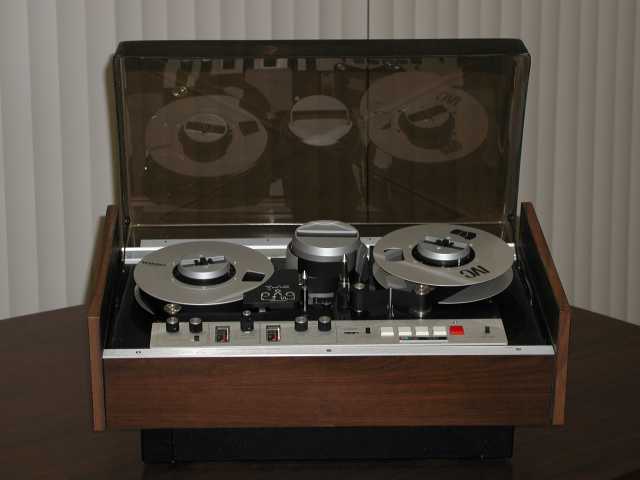
1972: IVC 700 Low Cost One Inch Color Video Recorder!
|
A wonderful artifact from International Video Corporation. Introduced in
the early 1970's, this is a stand alone full color VTR. The tape is wrapped
completely around the head drum, traveling in a counter clockwise direction,
entering at the lower left and exiting at the lower right (of the image).
Since the feed reel sits lower than the take up reel, tape travels "upwards"
as it traverses the circumference of the drum. This scanner has only one
video head, which protrudes a minute distance from the drum, and contacts
the tape. When running, the scanner spins the head around 60 times a second
in B/W mode and 59. 94 times per second in color. The rear portion of the
actual video head is visible inside the drum at about the "9 O'clock" position. |
This
machine also has only one audio track, as suggested by the "low cost" in
my title. There are controls to set both audio and video input and output
levels and meters to monitor those. There is a separate control for color
lock. Additional controls are provided for tracking and tape tension adjustments
as well. The connector panel contains jacks for video input, color (corrected)
video output, raw (unprocessed) video output, audio input and output, AC
power and remote control. The IVC 700 contains a built-in amplifier and
speaker for audio monitoring too. This machine is very heavy, weighing
in around 75 pounds (34 Kilograms).
NEEDED: Nothing! I have all of the manuals for this one! |
New Addition! 01.07.27
  
1977?: IVC 800A(SMR) One Inch Color Video Recorder
and its Video Head!
|
Another artifact from International Video Corporation. Introduced in the
mid 1970's, this is a stand alone full color VTR. A second feature is slow
motion playback capability. The first photo shows the top of the transport,
the second photo is a close up shot of the scanner assembly and the last
photo is of an actual video tape head. The one inch wide tape is wrapped
completely around the head drum, traveling in a counter clockwise direction,
entering at the lower left and exiting at the lower right (of the image).
Since the feed reel sits lower than the take up reel, tape travels "upwards",
in a helix, as it traverses the circumference of the drum. This scanner
has only one video head, which protrudes a minute distance from the drum,
and contacts the tape. When running, the scanner spins the head around
60 times a second in B/W mode and 59. 94 times per second in |
color. The rear portion of the video
head is visible inside the drum at about the "9 O'clock" position.
This machine also has two audio
tracks, one of which (channel two) can be re-recorded after the fact. There
are controls to set both audio and video input and output levels and meters
to monitor those. There is a separate control for color lock and another
for variable speed slow motion playback. Additional controls are provided
for tracking and tape tension adjustments as well. The connector panel
contains jacks for video input, color (corrected) video output, raw (unprocessed)
video output, audio inputs and outputs, AC power and remote control. This
machine is heavy, weighing around 75 pounds (34 Kilograms).
WANTED: Vintage magazine articles or any other information on this
and any other IVC machines. |
New Addition! 01.07.17
 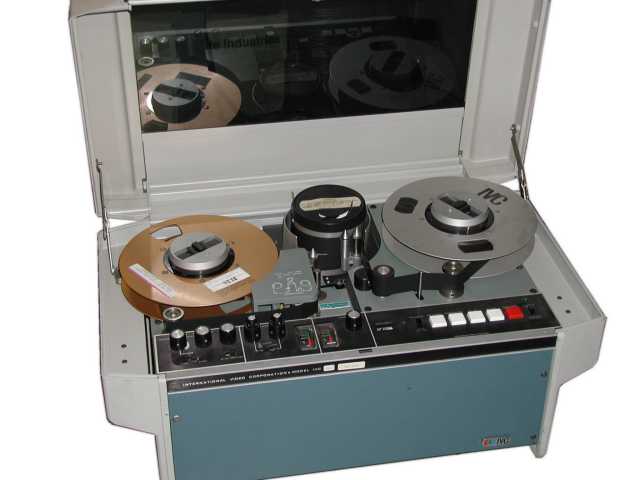
1978: IVC 816XA One Inch Color Capable Video Recorder!
This just in! A very rare artifact from IVC. Introduced in the mid 1970's,
this is a typical example of IVC's equipment. IVC made many models in this
series. This machine uses one inch video tape wrapped completely around
a drum with only one video head. This configuration is called, "Alpha Wrap".
When viewed directly from above, the tape path looks just like the greek
letter alpha. Linear tape speed is in the range of 9. 6 IPS (24. 384 cm/S),
giving about 1 hour recording time on 9. 25 inch diameter reel of broadcast
quality one inch tape. Along with excellent video bandwidth, this machine
also records two very high quality audio tracks as well. Audio channel
two can be dubbed independently too. The "X" in the model number of this
particular machine implies that it is electrically certified for medical
use. Even though it has those fancy handles on the end, it should still
be handled by two people to avoid back strain! It weighs in close to 70
pounds (150 Kg).
The machine naturally
records color or B/W video signals. To playback color, however, does require
either a TBC (Time Base Corrector) or a heterodyne type color adapter.
Heterodyne adapters work in a manner similar to all modern VHS machines
~ and just as poorly! A TBC can restore the playback quality to that of
nearly the live camera signal! These machines were used extensively in,
what I would call, second tier video establishments. These would be production
house that required fine quality but lacked the budget for the superior
quadruplex or 1" type C machines. A lot of these decks also served as dub
master decks in VHS and Betamax mass dubbing companies too.
SIDEBAR:
I (LabGuy) worked right
next door to IVC, in the same building, in 1981. The company I worked at, |
Videologic Corp., used IVC 800's in their
own product, a high speed video motion analyzer called the "InStar". This
stood for, "INSTant Analytical Replay". You take one IVC-800 VTR mechanism
and add custom made electronics, stand it on end and bolt it to a large
movers hand truck with pneumatic tires! (Yes, I had to check the pressure
in them as part of system test!) On top of this, you mount a 12" video
monitor and control panel. Wrap the whole thing in a rubber gasketed fiberglass
weather proof enclosures and throw in a 200 Watt strobe light (2,000 Watt
strobe optional) and a custom built plumbicon video camera. Now you are
good to go and record high speed motion events at up to 960 frames per
second! Playback speed is variable anywhere from real time to freeze frame
with perfectly clear images! Clever, huh? Saw one of those recently on
eBay! It was too expensive, too heavy and too useless. LabGuy's World waits
patiently for one of THOSE to be DONATED.
This IVC machine is almost
working. It is actually threaded up and running in the right hand photo.
It pulls tape perfectly and has a good video head. There is some sort of
problem with the electronic video path. Probably simple electronic misalignment
or dirty switch or relay contacts. SIMPLE, you ask? Yes! Simple, I say.
The the block diagram of these machines looks exactly like what you would
see in a text book on VTR theory. If it was any simpler, it couldn't run!
Because of their age, they contain very few, if any, integrated circuits.
The electronics are composed of discrete transistors, resistors, capacitors,
etc.. So, when it comes to understanding and repairing them, it is a rather
easy task.
WANTED: Vintage magazine articles or any other information on this
and any other IVC machines. |
New Addition! 01.04.02

1966: Sony EV-200 B/W One Inch Videocorder!
This just in! A very rare artifact from Sony. Introduced in the very early
1960's, this is the first "portable" VTR Sony offered for general consumption.
Notice the two handed handles on either side arranged for the two handed
convenience of two people! Compared to its predecessor and the Ampex machine
that follows, this machine was "tiny" and almost all solid state. Hey!
It only contains two rather large vacuum tubes! It weighs in at a petite
88 Lbs. And it's efficient, too! Only sucking 277 Watts of power to be
ready to use only
a couple of minutes after you turn the power
on! To cover up the lawn mower like sound of the video heads striking tape,
the EV-200 has a large almost sound proof cover (not shown) which can be
closed while the machine is operating.
This machine is a monochrome
only full field recorder with stereo sound tracks. Video connectors are
the large PL-259 type of the day and the audio connectors are all the professional
XLR type. The EV-200 uses one inch tape in a helical scan configuration
with 2400 feet of tape on eight inch reels running at 7. 8 IPS giving 63 |
minutes record / playback time. (Refer to
the second photo for tape pattern details.)
As mentioned earlier,
it has hybrid circuits - that is, solid state mixed with vacuum tubes.
The two large sweep tubes serve as the motor drive amplifier for the head
wheel servo. The EV-200 is interchange compatible with all Sony VTR's in
the EV and UV series. All of the models after this were color capable.
This one could be converted for color operation, but I doubt that very
many actually were. EV-200's sold for approximately $3750 and were manufactured
well into the late 1960's. A remote controllable version was called the
EV-200R.
WANTED: Service manuals, operator's manuals and vintage magazine
articles on this machine.
NEWS FLASH! 02.09.12: This VTR
can be seen in the movie, [Auto
Focus], starring Greg Kinnear and Willem DeFoe. This film opens October
18, 2002. |
New Addition! 04.11.17
  
1967: Sony EV-210 Color Capable One Inch Videocorder!
|
Here is the next unit in the EV series of VTRs from Sony. This VTR shares
all of the features of the EV-200 with the addition of color capability
by using the optional CLP-1B color adapter. (not shown) This adapter was
connected to the VTR by means of a standard EIAJ 10 pin extension cable.
The external color adapter was about the size of a standard toaster. |
Yes, this machine is actually running in the photographs. The image on
the monitor is a state of the art "graphic" from the live broadcast of
the Apollo 8 moon landing rehearsal flight actually recorded in 1968!
WANTED: A CLP-1B color adapter and or a CLP-1B service manual. |
New Addition! 01.05.20
 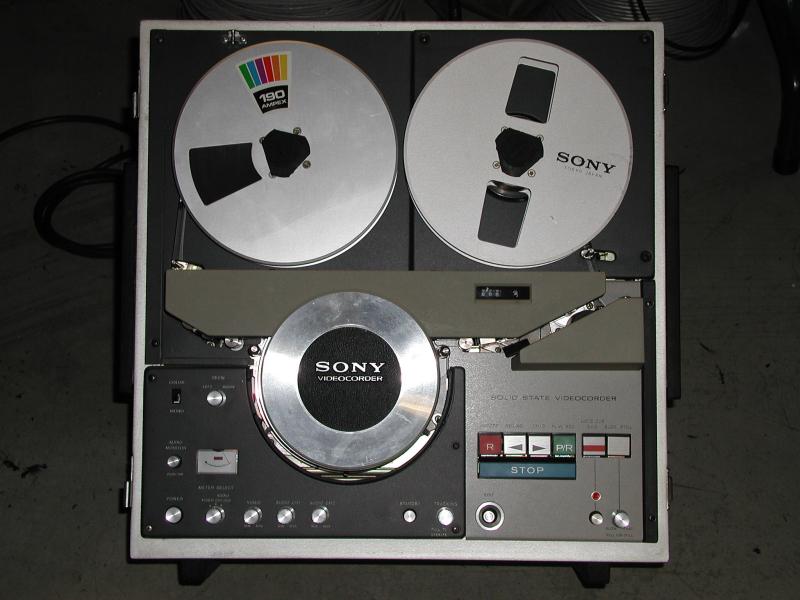
1968: Sony EV-310 Color Capable One Inch Videocorder!
|
This just in! Another very rare artifact from Sony. Introduced in the mid
1960's, this is a vast improvement over the earlier EV-200 series VTR's.
Not only that, LabGuy's World has obtained a second, more intact machine!
As you can plainly see in the second photo, this has real possibility for
restoration! Neither machine |
is working, but the latest one seems to only
need a mechanical cleaning and alignment. Stay tuned!
WANTED: Service and or Operators' Manuals, a head cover and or any
accessories for this machine. |
New Addition! 01.06.30
New Photos! 01.08.01
 
Sony EV-320F One Inch Videocorder and How To Thread
the Tape.
|
Late 1960's color one inch helical scan VTR, with flying erase heads and
"true" full electronic editing performance. 100% solid state. Color capable
with the use of the external and optional CLP-1B color pack. Stereo sound
tracks. Very heavy! This particular machine is alleged to have been used
to record an interview with television pioneer Philo T. Farnsworth. Cool!
The second photo is a close up of the threading diagram |
found on the inside of the removable top cover.
WANTED: A Sony EV-330 time lapse Videocorder to fill in the next
logical gap in the progression of these models. |
New Addition! 01.05.25
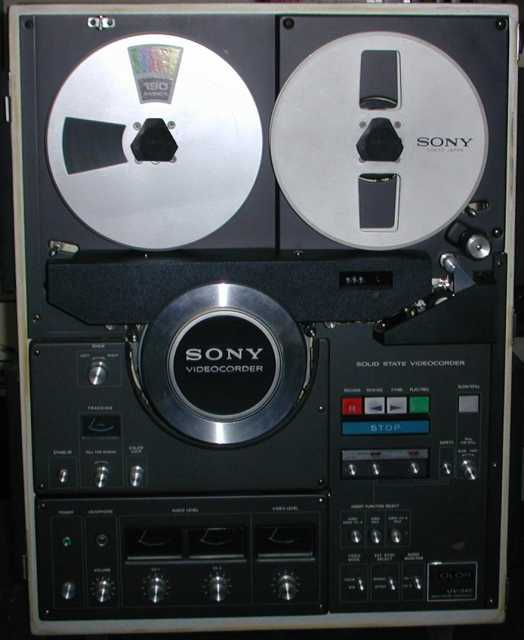 
1970?: Sony UV-340 One Inch Full Color Editing
Videocorder.
This is a Sony UV-340 One Inch Full Color VTR. This was the first of the
Sony one inch machines that did not require an external color adapter unit.
It was also the very last of the Sony one inch series of Videocorders.
The UV-320 draws 200
watts of power. it records EIA standard video signals, 60 Hz field frequency
monochrome or NTSC color video with 2:1 or random interlace. It uses two
head slant track scanning system FM recording. Color is direct recorded
as a 688 kHz converted subcarrier. It has stereo audio tracks and insert
and assemble editing features. Since it is only a two head system however,
it is not really a great editor. |
It also has full (wired) remote control ability
using the optional UVR-340 remote control unit (2nd photo).
This was the only machine,
of this series, that could record and playback color video without the
use of an external adapter. Color recordings made on the earlier machines,
using color adapters, are not compatible for color playback on this machine
and vice versa. The color under recording system used on the UV-340 is
identical to the system used on 3/4" Umatic machines to this very day.
This was a very sophisticated VTR for its time! This machine is
functional but does need some TLC before it is as good as the day it was
made. Stay tuned! |
Click here to:
Go
to the Next Exhibit: Quarter Inch format VTR's
Return
to the Exhibit Index
Return
to The Top of LabGuy's World
Last updated: November 17, 2004 |








































